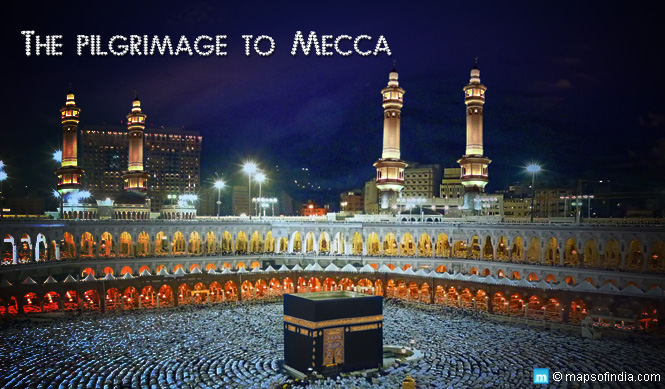What is Hajj?
The literal meaning of the word Hajj is “to continuously strive to reach one’s goal.” The Hajj, also referred as Pilgrimage to Mecca in Saudi Arabia or the fifth pillar of Islam, is an obligation or a duty or rather a lifetime opportunity for every Muslim to undertake if his health and financial conditions permit. For all Muslims, Hajj is the ultimate form of worship. Every year, nearly two million Muslims all across the globe meet at Mecca.
When is Hajj in 2015?
The pilgrimage takes place each year between the eighth and the thirteenth days of Dhu al-Hijjah, which is the 12th month of the Muslim lunar calendar. In 2015, Hajj is expected between September 21 and 26.
Significance of Hajj
• Every Muslim believes that Hajj will bring about a deep spiritual change to make a person better.
• Hajj teaches sincerity and humility in one’s relationship with God.
• A person who undertakes a Hajj pilgrimage is blessed with the values of justice, honesty, kindness, forgiveness, respect, generosity, mercy and empathy.
Prerequisites for Hajj Pilgrimage
A Muslim who intends to visit Mecca should be a free adult or a matured one with a sound mind and body. He should have the ability to afford the journey and at the same time his dependants back home should be financially secured during his trip.
The dress code
• The dress worn by the pilgrims is known as Ihram. It is a simple, unstitched white 2-piece garment worn by all men irrespective of their status, wealth, class and culture; one piece of garment covers the lower part of the body from waist to ankle and the other piece is thrown over the shoulder to cover the upper part.
• Muslim women wear a simple white dress and she should have her head covered. But she does not have to wear a veil.
• The heads of men must be uncovered.
• The pilgrim cannot shave, cut his nails or wear any jewellery during the journey.
Rites of Hajj: The five-six days of Hajj
• The first rite is the donning of the ihram at Makkah and his hajj starts right from there.
• On the first day, pilgrims move out of Makkah toward Mina, a small village east of the Mecca city. As the people gather at Mina, the pilgrims spend their time meditating and praying.
• During the second day, pilgrims leave Mina for the plain of “Arafat”, the central rite of the hajj. As they congregate there, the pilgrims join in prayers for God’s forgiveness. They stand there till sunset. This is known as Wuquf or standing.
• Just after sunset, the pilgrims move to Muzdalifah, an open plain which is halfway between Arafat and Mina. There they pray and collect pebbles to use on the following days.
• Before the sun sets on the fourth day, pilgrims move from Muzdalifah to Mina. There they cast pebbles at the white pillars. Pilgrims throw seven pebbles at each of these pillars, which represent Satan. This is known as the “Stoning of the Devil”.
• On the last day, the pilgrimage ends with a festival, called Eid Al-Adha. Here the pilgrims pray, sacrifice an animal, and the exchange of greetings and gifts takes place. Pilgrims leave Mecca. For some this continues till the sixth day.
Visa
• All potential pilgrims who prefer to go to Mecca should apply for a Hajj visa. This should be done through a qualified travel agent in their home country. The Saudi embassies do not issue visas to individuals travelling alone.
• All foreign travel agents must be pre-approved by the Ministry of Hajj and have a partnership contract with a local (Saudi).
• Quotas have been placed on the number of pilgrims from each country.
Norms in India
• In India, Hajj pilgrims either undertake pilgrimage through Haj Committee of India (HCOI) or Private Tour Operators (PTO).
Hajj Subsidy in India
• Every year the Government of India provides subsidy to the pilgrims. The subsidy amount has, however, reduced over the years from Rs.836.56 crores in 2012 to Rs. 533 crores. The practice for providing subsidy would be ended by 2022 as per a verdict by the Supreme Court. The reason for this reduction was that the subsidy amount was increasing every year in the previous years.
• Since 2000, over 1.5 million Muslims have used the subsidy.
• Ministry of Civil Aviation supervises the Air Charter operation during the period. Officials are employed for support in Saudi Arabia.
• The airfare per pilgrim charged during Hajj 2014 was Rs.35,000. This is a subsidised amount as the actual airfare ranges from Rs.63,750 to Rs.1,63,350 depending on the embarkation point in India. In 2015, Rs.42,000 will be charged as airfare from each Hajj pilgrim.
Arrangement and facilities by the Govt. of India
• The Ministry of External Affairs (MEA) coordinates the Haj arrangements. This is done in consultation with HCOI and Consulate General of India (CGI), Jeddah.
• MEA also sends 546 officials on deputation every year. These include Coordinators, Assistant Haj Officers, Doctors and Para-medical staff, Haj Assistants for providing assistance to the Haj pilgrims.
• The CGI, Jeddah arranges for temporary tents in Mina. Dispensaries and offices are set-up to arrange ambulances and other local transport for the pilgrims.
• Medicines and medical equipment are supplied by MEA to CGI, Jeddah. In the year 2014, medicines worth Rs. 2.60 crores were supplied.
• Haj Committee of India meets the costs of the Haj pilgrimage through the payments made by the pilgrims.
• The Haj pilgrims pay for the expenses on air travel, food and lodging, local transport within Saudi Arabia.
• No other external grant is provided by the MEA to HCI.
• This year over 136,000 Indians will visit Mecca to perform Haj. Air India will ply 230 special flights for Haj pilgrims from seven cities of India – Delhi, Mumbai, Goa Srinagar, Hyderabad, Kochi, and Nagpur. These flights will carry 38,000 Hajis to Jeddah.
Read Also
Information About Id ul Zuha
Eid al Fitr – More than celebrations




